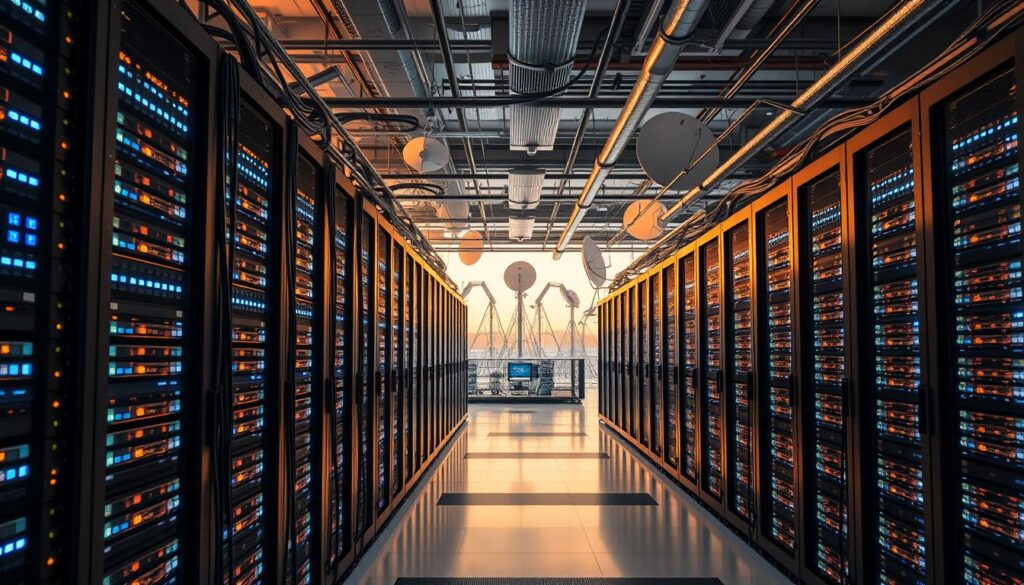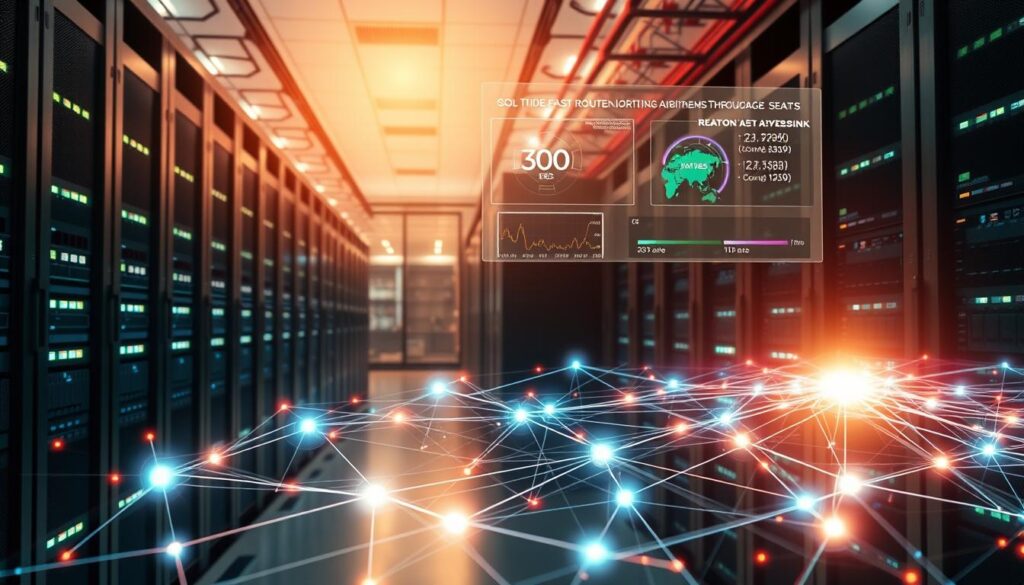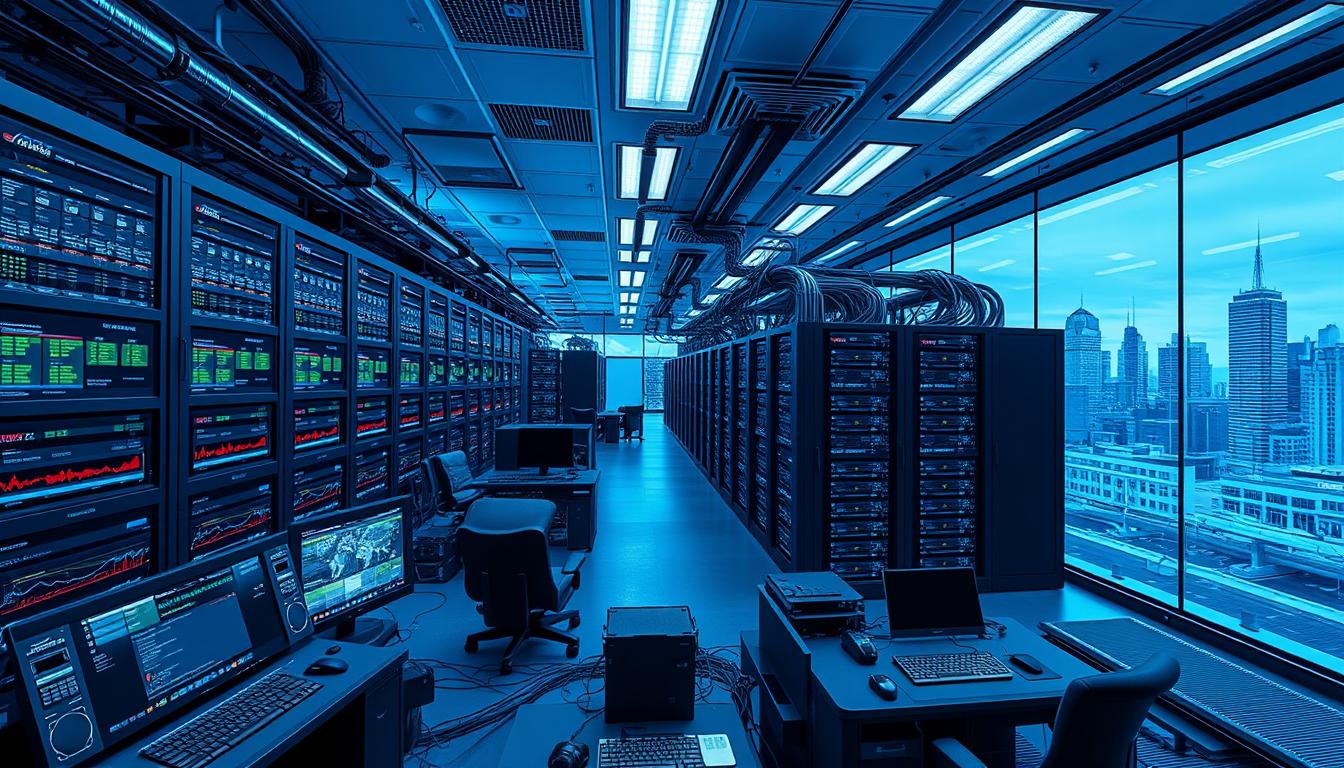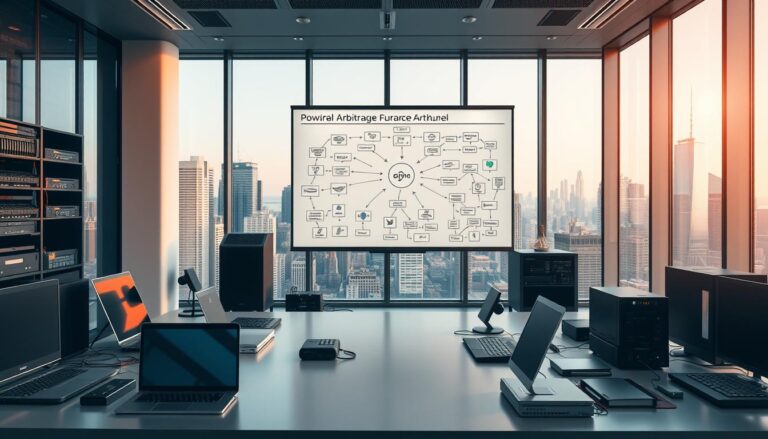High Volume Arbitrage: How to Handle Scale, Servers & Speed
Successful high volume arbitrage needs a robust infrastructure to manage massive data volumes, optimize servers, and accelerate trade execution. In 2025, arbitrageurs face an increasingly complex landscape with over 65% of equity markets being electronically traded and automation becoming the only viable way to engage in crypto arbitrage.
To overcome these challenges, mastering server optimization and implementing cutting-edge speed enhancement technologies is crucial. With revolutionary AI-powered systems and ultra-low latency infrastructure, arbitrageurs can significantly boost their trading performance and maintain market leadership.
Key Takeaways
- Understand the critical importance of handling scale in high-volume arbitrage with modern infrastructure.
- Learn 2025’s latest strategies for optimizing servers and achieving ultra-low latency.
- Discover AI-powered speed optimization techniques for maximum trading efficiency.
- Explore next-generation technologies including edge computing and quantum solutions.
- Implement scalable cloud infrastructure for handling massive data volumes.
Understanding the Evolving Challenges of High-Volume Arbitrage in 2025
The landscape of high-volume arbitrage has transformed dramatically in 2025. AI algorithms used in arbitrage trading bots are more advanced than ever, with machine learning models processing vast arrays of data sources from historical prices to social media sentiment and geopolitical events.
Ultra-Low Latency Requirements have become the new standard. Achieving ultra-low latency in trading means processing data in nanoseconds rather than milliseconds, requiring specialized hardware and software optimization.
Market Volatility and Speed Competition intensifies as competition speeds up price convergence, making automation essential with robots connecting directly to exchanges via API for instant order placement.
Infrastructure Complexity has exponentially increased with requirements for:
- FPGA-based hardware acceleration and custom ASICs for processing optimization
- Co-location services near exchange data centers for minimal transmission delays
- Network monitoring software providing real-time performance data to microsecond precision
- AI-powered predictive analytics for identifying high-probability arbitrage opportunities
To address these evolving challenges, arbitrageurs in 2025 must implement comprehensive strategies combining cutting-edge hardware, optimized software, and AI-driven automation systems.
Building Next-Generation Infrastructure for Scale in 2025
Creating a future-ready scalable infrastructure requires embracing the latest cloud computing innovations and edge technologies available in 2025.
Multi-Cloud and Hybrid Strategies dominate the market. 89% of enterprises embrace multi-cloud strategies, using an average of five cloud providers for greater flexibility and risk mitigation.
Leveraging Advanced Cloud Computing for Ultimate Scalability
Cloud computing in 2025 offers unprecedented benefits with global spending expected to increase by 21.5% and 96% of companies using public cloud services. Key advantages include:
- Dynamic Scaling: Serverless computing growth enables businesses to run code without managing servers, freeing up IT resources
- Enhanced Reliability: Cloud service uptime projected to reach 99.999% reliability for major providers
- Cost Optimization: Pay-per-use models with AWS forecasted to generate $126.5 billion in revenue with 18.3% growth
- AI Integration: AI deeply intertwining with cloud platforms at all levels, from infrastructure to platform services
Edge Computing Revolution
Edge computing is expected to reduce latency by 60% for cloud-based applications, with the market projected to reach $15.7 billion by 2025. For arbitrage operations, this means:
- Processing data closer to exchanges for faster execution
- Reduced network hops and improved response times
- Enhanced resilience with distributed computing nodes

By implementing these advanced infrastructure strategies, arbitrageurs can effectively tackle modern high-volume arbitrage challenges while positioning themselves for future growth and market opportunities.
Advanced Server Optimization Techniques for 2025
Revolutionary server optimization techniques in 2025 focus on achieving sub-microsecond latency and maximum throughput for competitive arbitrage operations.
Ultra-Low Latency Hardware Configuration represents the new gold standard. FPGA (Field Programmable Gate Array)-based hardware-accelerated network cards process data directly on hardware, bypassing software delays.
Essential hardware optimizations for 2025 include:
- High-frequency trading servers equipped with custom hardware including FPGAs and ASICs for enhanced efficiency
- PCIe-based SSDs for instantaneous read/write speeds and specialized NICs for high-speed data transmission
- Ticker plant hardware with increased processing speed and processor count to optimize data packet loading
- Custom-built algorithms optimized for speed, designed to react to market changes in microseconds
Software Architecture Optimization
Custom Linux OS distributions optimized for real-time data processing, with trading platforms written in C++, Rust, and Java for maximum execution speed. Key software strategies include:
- Kernel Bypass Techniques: Technologies like Solarflare, OpenOnload, and DPDK bypass the OS kernel, reducing network latency
- Direct Market Access: DMA empowers trading systems to send orders directly to exchange order books, skipping intermediary processes
- Load Balancing: Advanced distribution systems for handling increased trading volumes
- Real-time Monitoring: Continuous performance tracking to identify and resolve bottlenecks through root cause analysis
Network Infrastructure Optimization
Co-location services and dedicated cross-connects provide direct fiber connections between trader servers and exchange systems for consistent low-latency performance. Network optimization includes:
- Direct connections to exchange ports instead of intermediary hosting providers, reducing network switches
- High-speed connectivity solutions like fiber optic cables, satellite connections, and microwave links
- Mesh network connectivity linking multiple colocation centers for access to all major venues
These comprehensive optimization techniques enable arbitrageurs to achieve the ultra-low latency required for successful high-frequency trading in 2025’s competitive landscape.
High Volume Arbitrage: Mastering Scale, Servers & Speed in 2025
Maximizing speed and handling scale in 2025 requires leveraging the most advanced AI technologies and infrastructure solutions available.
AI-Powered Trading Revolution has transformed arbitrage strategies. AI algorithms can now analyze various factors like news sentiment, social media trends, and technical indicators to predict future price movements with unprecedented accuracy.
Key Strategies for 2025 Speed Maximization
- Advanced AI Integration: Reinforcement learning and neural networks allow bots to refine decision-making processes for more effective arbitrage opportunity identification
- High-Performance Computing: The high-frequency trading server market is expected to reach $1054.07 million by 2032, driven by demand for ultra-low latency solutions
- Real-time Analytics: Real-time cloud infrastructure innovations including edge computing and streaming analytics with the market valued at $22.34 billion in 2023
- Quantum Computing Integration: IBM aims to launch Flamingo system with over 1,000 qubits by 2025 for enhanced computational capabilities
Automated Trading Excellence
Over 65% of retail traders use automation to some degree, with institutional investors automating up to 99% of operations. Benefits include:
- 24/7 market monitoring without human intervention
- Instant reaction to opportunities with bots connecting directly to exchanges via API
- Elimination of emotional trading decisions and human errors
- Continuous adaptation to changing market conditions through machine learning algorithms
These advanced strategies enable arbitrageurs to maintain competitive advantages while scaling operations effectively in 2025’s rapidly evolving market environment.
Essential Tools and Software for 2025 Arbitrage Scaling
Arbitrage scaling in 2025 demands sophisticated technological solutions that leverage AI, cloud computing, and advanced analytics.
Next-Generation Trading Bots have evolved significantly. The global crypto arbitrage market is projected to reach 89% by 2028, with bots executing trades at lightning speed and analyzing vast amounts of data.
Advanced Trading Software Features
Modern arbitrage platforms in 2025 incorporate:
- AI-Powered Analysis: Statistical arbitrage analyzing historical data to identify patterns and correlations between crypto prices on different exchanges
- Multi-Exchange Integration: Support for multiple crypto exchanges with high liquidity like ByBit and other major platforms
- Real-time Processing: High-frequency trading capabilities handling large volumes of trades simultaneously for profit maximization
- Predictive Analytics: AI and big data analytics for sentiment analysis and market trend prediction
Cloud-Native Development Tools
75% of enterprises focus on developing cloud-native applications, with DevSecOps integrating security into development processes. Essential tools include:
- Microservices-based architectures for speed and modularity
- Containerization approaches for scalable cloud solutions and quick deployment
- Automated security tools and AI-driven threat detection systems
- Infrastructure as Code (IaC) for security and efficiency optimization
Emerging Technologies for 2025
- Blockchain Integration: Blockchain-as-a-Service market anticipated to grow by 50%
- IoT Connectivity: 75 billion IoT devices projected to connect to cloud platforms
- AR/VR Analytics: AR/VR cloud services market expected to grow by 70%
- 5G Integration: 10x faster data processing with 5G integration in cloud computing
Selecting platforms that integrate these cutting-edge technologies ensures arbitrage operations remain competitive and scalable as markets evolve throughout 2025 and beyond.
Speed Optimization Strategies for Ultimate Competitive Edge
Achieving superior speed optimization in 2025 requires implementing the most advanced latency reduction techniques and AI-powered processing systems available.
Ultra-Low Latency Infrastructure sets the foundation for competitive advantage. Ultra-low latency trading requires tick-to-trade latency under one microsecond, achievable through optimized hardware and direct exchange connections.
Advanced AI and Machine Learning Implementation
AI-powered tools for trend analysis and algorithmic trading enable detection of emerging trends before they become apparent. Key strategies include:
- Predictive Modeling: AI algorithms combining predictive analytics with real-time data processing to identify high-probability arbitrage opportunities
- Adaptive Learning: Continuous evolution of AI models through reinforcement learning for improved decision-making processes
- Real-time Processing: Advanced trading platforms with AI Optimizer modules analyzing historical data and optimizing strategies in real-time
- Risk Management: Comprehensive equity management features with hard stop-loss limits and dynamic position adjustments
Infrastructure Optimization Techniques
Achieving ultra-low latency requires meticulous optimization of both hardware and software components within IT infrastructure:
- Hardware Acceleration: Application-specific hardware including FPGAs for algorithms executing entirely within specialized devices
- Network Optimization: Packet minimization strategies and efficient data transmission protocols for reduced transmission times
- Co-location Services: Direct connections to exchange ports costing $12,000+ monthly for CME Globex connectivity
- Advanced Monitoring: Latency audits and high-speed connectivity solutions for continuous performance optimization

Emerging Speed Technologies for 2025
- Quantum Computing: Quantum computing market expected to grow to $1.7 billion by 2026 for enhanced processing capabilities
- Edge Computing: Over 50% of enterprise data will be processed at the edge by 2025, reducing latency significantly
- 5G Networks: Enhanced connectivity for faster data transmission and reduced latency
- Neuromorphic Computing: Brain-inspired computing architectures for ultra-efficient processing
By implementing these comprehensive speed optimization strategies, arbitrageurs can achieve the microsecond-level performance required to outperform competitors in 2025’s ultra-competitive trading environment.
Conclusion: Mastering High-Volume Arbitrage in 2025
High-volume arbitrage in 2025 demands a sophisticated approach combining cutting-edge infrastructure, AI-powered optimization, and ultra-low latency systems. With the high-frequency trading server market growing at 6.47% CAGR and reaching over $1 billion by 2032, the importance of advanced technological implementation cannot be overstated.
Success requires embracing AI integration, multi-cloud strategies, and edge computing innovations that define the future of cloud computing. The winners in this space will be those who invest in ultra-low latency infrastructure, FPGA-based hardware acceleration, and AI-driven trading algorithms.
Key success factors for 2025 include:
- Implementing sub-microsecond latency trading systems
- Leveraging AI and machine learning for predictive analytics
- Adopting cloud-native, scalable infrastructure solutions
- Utilizing advanced automation and real-time processing capabilities
As automation becomes the only viable way to engage in arbitrage trading, arbitrageurs must continuously evolve their technological capabilities to maintain competitive advantages and achieve superior trading results in an increasingly sophisticated market environment.
FAQ
What are the latest challenges in high-volume arbitrage for 2025?
In 2025, arbitrageurs face ultra-low latency requirements (sub-microsecond), increased AI competition, and the need for advanced automation. Success requires FPGA-based hardware, AI-powered algorithms, and co-location services near exchanges.
How can I achieve ultra-low latency in my arbitrage infrastructure?
Implement FPGA-based network cards, use custom Linux distributions, employ kernel bypass techniques like DPDK, and establish direct connections to exchanges. Co-location services and specialized hardware can reduce latency to nanoseconds.
What role does AI play in modern arbitrage trading?
AI analyzes vast data sources including social media sentiment, news, and historical patterns to predict market movements. Machine learning algorithms enable real-time decision-making and continuous strategy optimization for competitive advantages.
How important is cloud computing for arbitrage scaling in 2025?
Cloud computing is essential, with 96% of companies using public cloud services. Multi-cloud strategies, edge computing, and serverless architectures provide the scalability and reliability needed for high-volume operations.
What are the best trading technologies for 2025 arbitrage operations?
Advanced AI-powered trading bots, real-time analytics platforms, blockchain integration, and quantum computing capabilities. Focus on platforms offering multi-exchange connectivity and automated risk management features.
How do I ensure my arbitrage infrastructure scales effectively?
Implement microservices architectures, use containerization, leverage Infrastructure as Code (IaC), and adopt multi-cloud strategies. Edge computing and real-time processing capabilities are crucial for handling increased trading volumes.
What hardware is essential for competitive arbitrage trading in 2025?
FPGA-based hardware acceleration, custom ASICs, high-performance CPUs with specialized trading processors, PCIe-based SSDs, and ultra-low latency network cards. Co-location near exchanges is also critical for optimal performance.
How can automation improve my arbitrage trading results?
Automation enables 24/7 market monitoring, instant trade execution, elimination of human errors, and continuous strategy optimization. Over 65% of traders use automation, with institutional investors automating up to 99% of operations.






